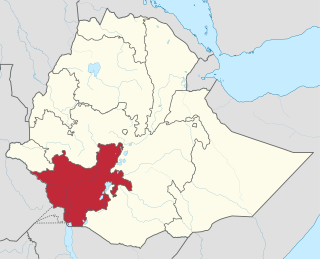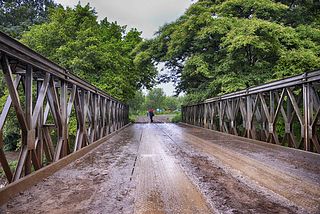Decha is one of the woredas in the Southern Nations, Nationalities, and Peoples' Region of Ethiopia. The name Decha comes from one of the provinces in the former Kingdom of Kaffa, which had the approximately same boundaries. Part of the Keffa Zone, Decha is bordered on the south by the Omo River which separates it from the Debub Omo Zone, on the west by the Bench Maji Zone, on the northwest by Chena, on the north by Ginbo, on the northeast by Menjiwo, on the west by Telo and Cheta, and on the southeast by the Denchya River which separates it from the Konta special woreda. The major town in Decha is Chiri.
Kemba is one of the woredas in the Southern Nations, Nationalities, and Peoples' Region of Ethiopia. Part of the Gamo Gofa Zone, Kemba is bordered on the southwest by the Debub Omo Zone, on the west by Uba Debretsehay, on the northwest by Zala, on the northeast by Deramalo, on the east by Bonke, and on the southeast by the Dirashe special woreda; the Weito River defines the boundary with Bonke and Dirashe. The major town in this woreda is Kemba.
Hamer is one of the woredas in the Southern Nations, Nationalities, and Peoples' Region of Ethiopia. It is named after Hamer people who live in this woreda. Part of the Debub Omo Zone, Hamer is bordered to the south by Kenya, to the southwest by Kuraz, to the west by Nyangatom, to the north by Bena Tsemay, and to the east by the Oromia Region; the Weito River separates it from the Oromia Region. Hamer includes part of Lake Chew Bahir along its southeastern border. The administrative center is Dimeka; other towns in include Turmi. Hamer was part of former Hamer Bena woreda.
Bako Gazer is one of the woredas in the Southern Nations, Nationalities, and Peoples' Region of Ethiopia. It is also called Southern Aari as it is part of the homeland of Aari people. Part of the Debub Omo Zone, Bako Gazer is bordered on the south by Bena Tsemay, on the west by the Mago River which separates it from Selamago, on the north by the Basketo special woreda and Gelila, on the northeast by the Gamo Gofa Zone, and on the east by Male. The administrative center of this woreda is Jinka; other towns in Bako Gazer include Tolta and Wub Hamer. Gelila and Male woredas were separated from Bako Gazer.
Sheko is one of the woredas in the Southern Nations, Nationalities, and Peoples' Region of Ethiopia. It is named for the Sheko people, whose homeland lies in this woreda. Part of the Bench Maji Zone, Sheko is bordered on the south by Debub Bench, on the west by Guraferda, on the northwest by the Gambela Region, on the north by the Sheka Zone, and on the east by Semien Bench. Towns in Sheko include Sheko. The western part of this woreda was added to Dimma woreda and central part of it was used to create Guraferda woreda.
Meinit was one of the 77 woredas in the Southern Nations, Nationalities, and Peoples' Region of Ethiopia. Part of the Bench Maji Zone, Meinit was bordered on the south by Dizi, on the west by Sheko, on the north by Bench, on the east by the Keficho Shekicho Zone, and on the southeast by the Omo River which separated it from the Debub Omo Zone. Towns in Meinit included Bachuma, Kela Ketema and Jemu. Meinit was separated for Meinit Goldiya and Meinit Shasha woredas.
Maji is one of the woredas in the Southern Nations, Nationalities, and Peoples' Region of Ethiopia. Part of the Bench Maji Zone, Maji is bordered on the south by the Kibish River which separates it from South Sudan, on the west by Surma, on the northwest by Bero, on the north by Meinit Shasha, and on the east by the Omo River which separates it from the Debub Omo Zone. Towns in Maji include Tum and Maji. The western part of Maji was separated to create Bero woreda and some southern kebeles were added to Nyangatom woreda.
Melokoza is one of the woredas in the Southern Nations, Nationalities, and Peoples' Region of Ethiopia. Part of the Gamo Gofa Zone, Melokoza is bordered on the south by Basketo special woreda, on the southwest by the Debub (South) Omo Zone, on the northwest by the Konta special woreda, on the north by the Dawro Zone, and on the east by Demba Gofa and Geze Gofa; the Omo River defines its northwestern boundary separating the woreda from Konta and the Dawro Zone. The major town in Melokoza is Leha.
Gelila is one of the woredas in the Southern Nations, Nationalities, and Peoples' Region of Ethiopia. It is also called Northern Aari as it is part of the homeland of Aari people. Part of the Debub Omo Zone, Gelila is bordered on the south by Bako Gazer, on the north by the Basketo special woreda, and on the east by the Gamo Gofa Zone. Gelila was separated from Bako Gazer woreda.
Bena Tsemay is one of the woredas in the Southern Nations, Nationalities, and Peoples' Region of Ethiopia. It is named after Banna and Tsamai people who are living at this woreda. Part of the Debub Omo Zone, Bena Tsemay is bordered on the south by Hamer, on the west by Selamago, on the north by Bako Gazer and Male, on the northeast by the Dirashe special woreda, on the east by the Konso special woreda, and on the southeast by the Oromia Region; the Weito River separates it from Konso special woreda and Oromia Region. Western part of this woreda is included in the Mago National Park. The administrative center is Key Afer. Bena Tsemay was part of former Hamer Bena woreda.
Male is one of the woredas in the Southern Nations, Nationalities, and Peoples' Region of Ethiopia. It is named after the Maale people who are living at this woreda. Part of the Debub Omo Zone, Male is bordered on the south by Bena Tsemay, on the west by Bako Gazer, on the north by the Basketo special woreda and Gelila, on the north and east by the Gamo Gofa Zone, and on the southeast by Dirashe special woreda. Male was separated from Bako Gazer woreda.
Nyangatom is one of the woredas in the Southern Nations, Nationalities, and Peoples' Region of Ethiopia. It is named after Nyangatom people who live at this woreda. Part of the Debub Omo Zone, Nyangatom is bordered on the south by Kuraz, on the west by the Ilemi Triangle, on the northwest by the Bench Maji Zone, on the north by Selamago, and on the east by Hamer. The Omo River is flowing along the northern and western border of Nyangatom. Nyangatom was separated from Kuraz woreda.
Uba Debretsehay is one of the woredas in the Southern Nations, Nationalities, and Peoples' Region of Ethiopia. Part of the Gamo Gofa Zone, Uba Debretsehay is bordered on the south and west by the Debub Omo Zone, on the north by Oyda and Demba Gofa, on the northeast by Zala, and on the east by Kemba. Towns in Uba Debretsehay include Beto. Uba Debretsehay was part of former Zala Ubamale woreda.
Oyda is one of the woredas in the Southern Nations, Nationalities, and Peoples' Region of Ethiopia. It is named after Oyda people living in this woreda. Part of the Gamo Gofa Zone, Oyda is bordered on the south by Uba Debretsehay, on the west by the Debub Omo Zone, on the north by Geze Gofa, and on the northeast by Demba Gofa. Oyda was part of former Gofa Zuria woreda.
Guraferda is one of the woredas in the Southern Nations, Nationalities, and Peoples' Region of Ethiopia. Part of the Bench Maji Zone, Guraferda is bordered on the south by Bero, on the west and north by the Gambela Region, on the northeast by Sheko, on the east by Debub Bench, and on the southeast by Meinit Shasha. Towns in Guraferda include Guraferda. Guraferda was separated from Sheko woreda.
She Bench is one of the woredas in the Southern Nations, Nationalities, and Peoples' Region of Ethiopia. It is named after the subgroup of Bench people. Part of the Bench Maji Zone, She Bench is bordered on the east and south by Meinit Goldiya, on the west by Debub Bench, on the northwest by Semien Bench, and on the north by the Keffa Zone. She Bench is part of former Bench woreda.
Meinit Goldiya is one of the woredas in the Southern Nations, Nationalities, and Peoples' Region of Ethiopia. Part of the Bench Maji Zone, Meinit Goldiya is bordered on the south by Meinit Shasha, on the west by Debub Bench, on the northwest by She Bench, and on the north and east by the Keffa Zone. Towns in Meinit Goldiya include Bachuma. Meinit Goldiya was part of former Meinit woreda, southern part of Bench woreda was added to Meinit Goldiya.
Meinit Shasha is one of the woredas in the Southern Nations, Nationalities, and Peoples' Region of Ethiopia. Part of the Bench Maji Zone, Meinit Shasha is bordered on the south by Maji, on the southwest by Bero, on the west by Guraferda, on the north by Debub Bench and Meinit Goldiya, on the east by the Keffa Zone, and on the southeast by the Omo River which separates it from the Debub Omo Zone. Towns in Meinit Shasha include Jemu. Meinit Shasha was part of former Meinit woreda.
Bero is one of the woredas in the Southern Nations, Nationalities, and Peoples' Region of Ethiopia. Part of the Bench Maji Zone, Bero is bordered on the south by Surma, on the west by the Gambela Region, on the north by Guraferda, on the northeast by Meinit Shasha, and on the east by Maji. Bero was separated from Maji woreda.
Semien Bench is one of the woredas in the Southern Nations, Nationalities, and Peoples' Region of Ethiopia. It is named for the Bench people. Part of the Bench Maji Zone, Semien Bench is bordered on the southwest by Debub Bench, on the west by Sheko, on the northwest by the Sheka Zone, on the east by the Keffa Zone, and on the southeast by She Bench. Semien Bench is part of former Bench woreda.




